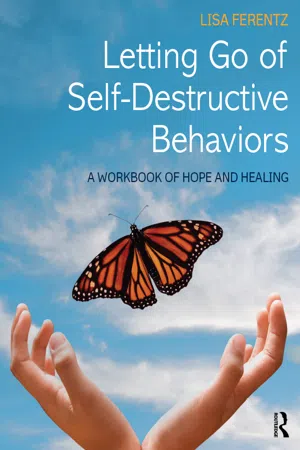![]()
PART I
TAPPING INTO YOUR CURIOSITY AND COURAGE
![]()
1
BEGINNING THE JOURNEY
“I know that hurting my body isn’t really a good idea, but I feel like I can’t stop.”
“When I starve all day, I feel kind of powerful. Until I feel dizzy and out of control again.”
“When I hook up with men I don’t know why my friends get upset. They seem a lot more worried about it than I do!”
“Drinking is a way to cope. Why can’t my family understand that?”
“If I had another way to feel better and stop the pain inside of me, I guess I’d try, but I don’t feel like there is any other way.”
“At least when I’m thinking about my cutting, I’m not thinking about other things in my life that have hurt me!”
Do you relate to any of those thoughts? Do you ever feel scared or upset by your behaviors yet struggle with the idea of stopping or changing them? Have you ever tried to give them up but found it too hard? Having spent many years working with people who do self-destructive or self-harming behaviors, I’ve learned that the healing journey often begins with two main qualities: courage and curiosity. It takes tremendous courage to say, “There may be a problem with what I’m doing,” or “It’s possible that what I’ve been doing isn’t working for me anymore.” Being courageous doesn’t mean that you’re not afraid. In fact, if any of us waited until we weren’t afraid before taking a challenging new step, we might never consider moving ahead. You can be afraid and do it anyway. Whether that means trying out a new behavior, entertaining a new idea, or letting go of old thoughts and behaviors that are familiar but are also harmful to your physical or emotional safety and wellbeing.
Once you notice your courage and tap into it, you can allow yourself to be curious about other options. This moves you even further along in your recovery process. Being curious about new possibilities works best when you approach this with an open heart and an open mind. It may feel natural for you to quickly judge or rule out new options. Change can feel scary, even when you’re sure change will make things better for you. It’s ok to be scared or confused as you consider new ways of coping. It’s natural to hesitate when you don’t have other ways of getting relief. Give yourself permission to be curious in a compassionate and non-judgmental way. In order to grow, you have to be curious – otherwise, things stay the same. They may be predictable but they aren’t really better. You have already taken a step in the right direction by giving yourself permission to be curious about this workbook!
Although reading this and participating in the journaling, drawing, and behavior exercises can be an important step in helping you let go of your self-destructive behaviors, it’s important to state that no one can make you stop whatever it is you are doing. The decision to be free of those behaviors and to replace them with healthier ones has to come from you. And the truth is it’s really hard to give up what you do know—even if it seems to be creating problems for you—and replace it with behaviors you don’t know—even if they appear to be in your best interest.
That’s why the only thing you really need to get started is the willingness, the courage, to say, “Maybe there’s a better way to get my needs met,” and the curiosity to say, “I’m willing to listen and learn.” In the end, the decision will be yours. The great news is there are other safer behaviors that allow you to achieve the temporary, positive results that you get from self-destructive behaviors. The difference is these new options will give you results that last, and won’t create the same negative side effects that you are probably experiencing such as guilt, shame, fear, loss of control, or unwanted physical pain.
It’s important to realize that there are positive benefits from your behaviors. You wouldn’t be doing them if you didn’t get something from them! It takes courage to admit that there are powerful negative outcomes as well. Together, we will explore the common positive and negative consequences of hurting the body or doing addictive behaviors. Understanding the “pay-off” can reduce the confusion and shame associated with why you keep going back to the behaviors. Understanding the very real downsides to your actions gives you the opportunity to re-think whether or not it would be in your best interest to learn other ways of coping and feeling better.
If you are like most people who abuse substances, have an eating disorder, engage in other addictive behaviors, or injure your body through acts of self-harm or self-mutilation, you have spent a lot of energy trying to explain the importance of your behaviors to loved ones, or attempting to downplay the negative consequences of your actions. This makes sense when those behaviors feel like the only helpful way to soothe or be numb, distract from other painful feelings or memories, or even feel alive in some way. Anyone who got that kind of relief would stay deeply invested in continuing the behaviors. They become an important resource for coping. And when you get relief in the short term, it makes it more likely that you will repeat the same behaviors in the future. Even when your loved ones or a therapist try to convince you that what you’re doing is “bad for you,” the behavior may be the only coping strategy you know and trust, and you will want to cling to it like a lifeline.
It’s also confusing and complicated when well-meaning people in your life ask you to explain why you are doing something destructive. Many people who struggle with these behaviors can’t explain to others why they feel the need to hurt themselves. This can create feelings of guilt, shame, and a self-diagnosis of being “weird” or “crazy.” It also fuels a reaction of frustration, fear, or anger in others when there are no answers. Twenty-three-year-old Stephanie illustrates this when she says:
My parents caught me throwing up—again—and this time they got really angry. They demanded to know why I keep doing this to myself. And the more they pushed, the more I realized I had no answer. That actually scared me a lot and made me realize how out of control this had become for me.
That’s where this workbook can be helpful to you. Together we will explore—without judgment—the most common reasons why people do self-destructive behaviors. We will connect the behaviors to several specific experiences. It may relate to the challenges and changes that come with adolescence. It might be the result of having witnessed or experienced trauma, abuse, or neglect. Or it might be the byproduct of having an upsetting story to tell from life events or stressful experiences that haven’t been resolved. I often refer to this as a “pain narrative.” Connecting what you have been doing to the difficulties that go with being a teenager is useful because the beginning of adolescence is often associated with the start of self-destructive behaviors. That’s not to say that only teenagers do these behaviors, or that it only begins in adolescence. Many people stumble upon self-destructive behaviors that seem to help them when they are much younger. And many people keep doing these behaviors well into older adulthood. But as you’ll see, adolescence can be a particularly vulnerable time, partly because we are willing to take greater risks, so self-harm is often discovered around this age. Or there is an increase in existing destructive behaviors as teens attempt to cope with the additional stress that comes with being an adolescent.
Fifteen-year-old Artie has an alcoholic father and a mother who copes by “pretending Dad doesn’t really have a problem.” He helps us make the connection between self-destructive behavior and adolescence. You may relate to this if you are a teenager, or if you once felt this way when you were younger.
When I was a kid I think it was easier to go along with my Mom’s strategy. We downplayed my Dad’s drinking and looked the other way so it didn’t seem so bad. We tried to focus on the “good times” with Dad and ignored the bad times. But when I turned 13, I started to feel so stressed by school. I felt insecure and thought that girls didn’t like me. The added pressure made it harder and harder to ignore stuff at home. I needed another way to tune it out and not deal with it. I had experimented with pot when I was 11, but by the time I was 14 I was getting high everyday. It seemed like a better solution. When I was stoned nothing mattered, which was fine with me, because letting it matter hurt too much.
Later on we will explore in more detail the specific challenges of adolescence and how they often serve as “tipping points,” causing teens to turn to self-destructive behaviors or up the ante with existing ones. It is certainly true that not everyone who has a problem with drugs, alcohol, eating, cutting, or sexual addictions has been abused or neglected in childhood. However, it is reasonable to assume that anyone who does those behaviors has an upsetting story to tell about something they experienced or witnessed that made them feel unsafe or betrayed their sense of trust. Typically this is an experience that cannot be expressed with words. And yet the person still needs to be comforted in some way. When something has interfered with their ability to self-soothe in healthy ways, they turn to destructive behaviors.
Traumatic experiences affect people in different ways, and some people can function at higher levels than others even with the effects of trauma. But anyone who has been through physical, emotional, psychological, verbal, or sexual abuse or some form of neglect pays a price and often suffers silently. There can be a big difference between an outer appearance of confidence and competence and inner feelings of inadequacy and shame. Sometimes trying to manage those opposite feelings creates more pain that needs to be soothed. Sometimes the resurfacing of painful or old memories and feelings needs to be pushed aside or comforted. Self-destructive acts can feel like a way to manage the leftover pain from these past traumatic or distressing experiences. Fifty-year-old Mary shows us this when she says:
I was a very successful businesswoman, who seemingly had it all! Everyone thought I had it together and probably would have been shocked and horrified to know that I was bingeing and purging almost nightly, and then crying myself to sleep. I felt haunted by memories of my grandfather inappropriately touching me. I felt dirty and damaged. It didn’t matter how pretty or accomplished I was, that almost made it worse, because no one saw how much I was hurting or believed I could have such intense pain.
Future chapters will help you understand the importance of exploring the possible connection between self-destructive behaviors and prior traumatic or painful experiences. Identifying, working through, and resolving these “pain narratives” or painful life experiences, will eventually make the need to engage in self-destructive acts unnecessary for you.
One of the most important ideas I hope you get from this workbook is what you have been doing makes sense given what you have experienced in the past. We will look at these behaviors through a strengths-based, “de-stigmatized” lens...

